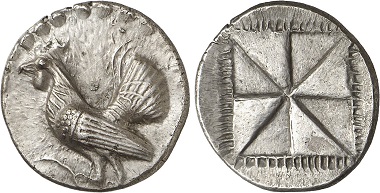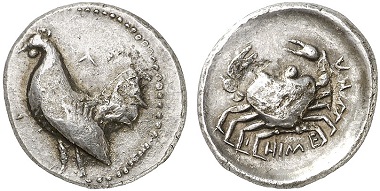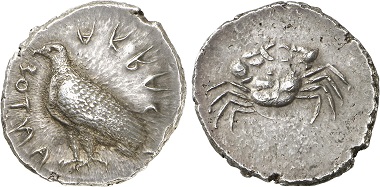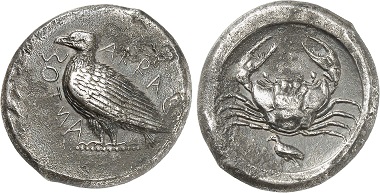translated by Annika Backe
It was the dispute between Himera and Acragas that led the Carthaginians to intervene against Syracuse. Here you learn more about the background and the coin types that these two cities issued.
Himera. Drachm, ca. 530-520. From Gorny & Mosch Auction 236 (2016), 28.
Himera’s rooster
Founded from Zankle around 650, Himera was the only major Greek city on the northern coast of Sicily, neighboring the Phoenician trading posts Panormos and Solus. Perhaps it is no coincidence that the beginning of the Archaic coin minting in Himera roughly coincided with the Carthaginians and Etruscans taking part in the Battle of Alalia in 540. Through this battle, the Carthaginians gained access to the silver supplies of Spain. Because it did not possess any significant natural resources of precious metal itself, Sicily depended on imports for its coinage. Himera probably got the silver it needed for its comprehensive coinage from the Carthaginians with whom it lived in a peaceful coexistence. The interpretation of the rooster shown on the obverse is a matter of debate. Several explanations are possible.
Himera. Litra, ca. 530-483. From Gorny & Mosch Auction 219 (2014), 28.
Perhaps this ambiguity was actually intended when the design for the coin was chosen. Firstly, as an attribute of healing deities (even Socrates is known for having placed an emphasis on sacrificing a rooster in honor of Asclepius) the animal might hint at the healing springs located not far from the city. Secondly, the rooster might act as an example of canting arms here. The Greek ‘Hemera’ translates as the day that is announced by the cock’s crow. A third explanation refers to the home of a part of the colonists: Euboia where the city of Carystus also minted coins that featured a rooster.
Himera. Didrachm, 483-472. From Gorny & Mosch Auction 212 (2013), 1112.
Around 483, Theron, tyrant in Acragas, father-in-law of Gelon and son-in-law of Gelon’s brother Polyzelos, attacked Terillus in Himera and expelled him. Thanks to his good connections with Carthage, the leading official of Carthage, Hamilcar, being a guest friend of Terillus, he managed to persuade the Carthaginians to intervene.
Gelon prevailed and Theron was able to hold his ground. He appointed his son Thrasydaios as tyrant of Himera. Because he intended to express his dynastic ties with Acragas in his coinage as well, he chose the crab as motif to be featured on the reverse of the coins from Himera. More of an economic and practical nature was the reason for a second modification he introduced. He no longer followed the Chalcidian monetary standard but adopted the Attic standard, which was also in use in his hometown Acragas. This is very likely to have facilitated the trade between the two cities and the cash flow significantly.
The coin emission ends in 472 with the fall of Thrasydaios. After his father’s death he had assumed control over Himera and Acragas. He tried to compensate his unpopularity with the local people by external military successes. Having chosen much more powerful Hieron of Syracuse as an opponnent, he failed miserably. Taking advantage of his temporary weakness, the citizens of Himera and Acragas expelled him and established autonomous democracies again.
Acragas. Didrachm, 510-500. From Gorny & Mosch Auction 228 (2015), 16.
Acragas
The coinage of the city begins with didrachms whose production is only terminated after the end of the tyranny of Theron in Acragas.
Acragas. Tetradrachm, 450-420. From Gorny & Mosch Auction 229 (2015), 1045.
Afterwards there is a gap in the city’s coinage; then, after having become a democracy, around 465, the city starts issuing coins again, whose weight, however, is now following the Syracusan tetradrachm. As motif for its coins Acragas chose the eagle of Zeus to whom a major, perhaps even the city’s main cult was dedicated. We know, for instance, that after the Battle of Himera Theron erected a temple in honor of Zeus.
Acragas. Tetradrachm, 450-430. From Gorny & Mosch Auction 195 (2011), 34.
The large beak and the heavy, feather-covered feet of the bird identify the animal as a sea eagle, corresponding to the geographical position of the city. The river crab on the coin’s reverse, on the other hand, points to the river Acragas which washes around the castle rock. Perhaps there is another example of the canting arms hidden here. The Greek ‘Charchinos’ for river crab may remind some people of Acragas.
This article was originally published in MünzenRevue 3/1997.
Please find all parts of this series in our archive.
If you are interested in Sicily, you should certainly check out the numismatic diary ‘Sicily in full bloom’. Find this series also in our archive.











